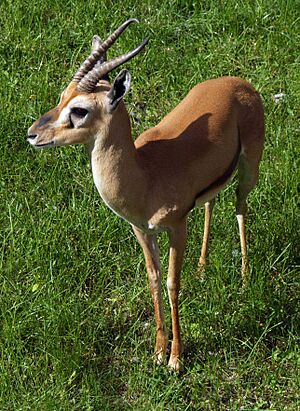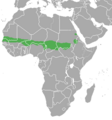Red-fronted gazelle facts for kids
Quick facts for kids Red-fronted gazelle |
|
|---|---|
 |
|
| Conservation status | |
| Scientific classification | |
| Genus: |
Eudorcas
|
| Species: |
rufifrons
|
| Subspecies | |
|
5 subspecies, see text |
|
 |
|
| Red-fronted gazelle range | |
| Synonyms | |
|
Gazella rufifrons |
|
The red-fronted gazelle (Eudorcas rufifrons) is a type of gazelle found across the middle of Africa. You can find them from Senegal in the west all the way to northeastern Ethiopia in the east.
These gazelles mostly live in the Sahel zone. This is a narrow band of land that stretches across Africa, just south of the Sahara Desert. They like dry grasslands, savannas with trees, and areas with lots of shrubs.
Some experts believe that Thomson's gazelle, which lives in East Africa, is actually a type of red-fronted gazelle. The red-fronted gazelle used to be part of a different group called Gazella. Now, it has its own group, Eudorcas.
Contents
Understanding the Red-Fronted Gazelle's Name
The scientific name for the red-fronted gazelle is Eudorcas rufifrons. A British zoologist named John Edward Gray was the first person to describe it. Scientific names help scientists around the world know exactly which animal they are talking about.
Different Kinds of Red-Fronted Gazelles
There are several types, or subspecies, of the red-fronted gazelle:
- Eudorcas rufifrons centralis – This one is found in eastern Chad.
- E. r. hasleri – This type lives in northern Nigeria.
- E. r. kanuri – Also found in some parts of Africa.
- E. r. laevipes – This subspecies is known as the Nubian red-fronted gazelle.
- E. r. rufifrons – This is the original type, found in Senegal.
What Does a Red-Fronted Gazelle Look Like?
Both male and female red-fronted gazelles are about the same size. They both have cool, S-shaped horns. Their bodies are a light reddish-brown color. However, their bellies and bottoms are white.
They have a clear, thin black stripe that runs along their sides. This stripe is about 2 to 4 centimeters (1 to 2 inches) tall. Their faces have two white stripes that go from their eyes to the corners of their mouths. These stripes are brighter than those on the red gazelle, which can sometimes be confused with the red-fronted gazelle. They also have a black tuft of fur on their tail.
Young red-fronted gazelles, called fawns, weigh about 7.8 kilograms (17 pounds). Adult gazelles can weigh up to 29.7 kilograms (65 pounds). When they are young, their shoulders are about 38.7 centimeters (15 inches) high. Adults can reach about 68.7 centimeters (27 inches) at the shoulder.
Scientists at Waza National Park studied red-fronted gazelles between 1989 and 1993. They measured many things like body length, horn length, and weight from 141 gazelles. This helped them learn more about these animals.
Where Do Red-Fronted Gazelles Live?
The red-fronted gazelle lives in many African countries. These include Burkina Faso, Cameroon, Central African Republic, Chad, Eritrea, Ethiopia, Mali, Mauritania, Niger, Nigeria, Senegal, South Sudan, and Sudan.
They like to live in places with semi-dry grasslands and savannas. They also enjoy savanna woodlands and areas with lots of bushes. These gazelles can even live in large pastures and old farms if there is some cover. They often move between different habitats depending on the season.
How Red-Fronted Gazelles Live and Behave
Red-fronted gazelles live in the Sahel zone. They are not very good at living in extremely dry places. During the rainy season, they might feed along the southern edge of the Sahara Desert. But when the dry season comes, they have to move south to find enough water.
These gazelles usually live alone, in pairs, or in small groups of up to six individuals. Sometimes, larger groups of up to 15 gazelles have been seen. They mostly eat grass, but they also munch on leaves from trees and shrubs.
Their main predators are big hunters like lions, leopards, cheetahs, hyenas, and African wild dogs.
Reproduction and Life Cycle
A female red-fronted gazelle gives birth to one baby, called a fawn. The baby grows inside its mother for about 184 to 189 days. The fawn will likely stop drinking its mother's milk when it is about three months old.
Female gazelles can start having babies when they are about nine months old. Males might not be ready to breed until they are about 18 months old. In zoos, these gazelles can live for up to 14.5 years. In the wild, they can have babies throughout most of the year.
When a baby fawn is born, its mother hides it in a safe spot. She then visits it to feed it milk. This helps keep the baby safe from predators.
How Are Red-Fronted Gazelles Doing?
There are about 25,000 red-fronted gazelles left in the world. Sadly, their numbers are going down. They face several dangers, including illegal hunting and their homes being destroyed. They also have to compete with farm animals for food and space.
When too many farm animals graze in their habitat, the gazelles have to move somewhere else. Also, land being cleared for farming takes away their homes. Because of these problems, many groups of red-fronted gazelles are now small and scattered.
The International Union for Conservation of Nature (IUCN) has listed the red-fronted gazelle as "vulnerable". This means they are at a high risk of becoming extinct in the wild.
About 15% of these gazelles live in protected areas. These include places like W National Park (in Niger, Burkina Faso, and Benin) and Waza National Park (in Cameroon). They also live in Zakouma National Park (Chad), Dinder National Park (Sudan), and Manovo-Gounda St. Floris National Park (Central African Republic). Some red-fronted gazelles have also been brought back to the Guembeul Natural Reserve and Djoudj National Bird Sanctuary in Senegal.
Images for kids




